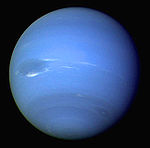- Neso (moon)
-
Neso Discovery [1][2] Discovered by - M. Holman et al.
- B. Gladman et al.
Discovered August 14, 2002 Mean Orbital elements [3] Epoch June 10, 2003 Semi-major axis 49.285 Gm Eccentricity 0.5714 Inclination 136.439° * Orbital period 9740.73 d
(26.67 a)Physical characteristics Mean diameter 60 km[4] ** Rotation period ? Albedo 0.04 assumed[4] Color ? Spectral type ? *to the ecliptic **based on the albedo Neso (
 /ˈniːsoʊ/ nee-soh; Greek: Νησώ), also known as Neptune XIII, is the outermost irregular natural satellite of Neptune. It was discovered by Matthew J. Holman, Brett J. Gladman, et al. on August 14, 2002, though it went unnoticed until 2003.[2][5]
/ˈniːsoʊ/ nee-soh; Greek: Νησώ), also known as Neptune XIII, is the outermost irregular natural satellite of Neptune. It was discovered by Matthew J. Holman, Brett J. Gladman, et al. on August 14, 2002, though it went unnoticed until 2003.[2][5]Neso orbits Neptune at a distance of more than 48 Gm (million km), making it the most distant known moon of any planet.[A] It follows a highly inclined and highly eccentric orbit illustrated on the diagram in relation to other irregular satellites of Neptune. The satellites above the horizontal axis are prograde, the satellites beneath it are retrograde. The yellow segments extend from the pericentre to the apocentre, showing the eccentricity.
Neso is about 60 km in diameter, and assuming the mean density of 1.5 g/cm3[6] its mass is estimated at 1.6×1017 kg.
Given the similarity of the orbit's parameters with Psamathe (S/2003 N 1), it was suggested that both irregular satellites could have a common origin in the break-up of a larger moon.[4]
Neso is named after one of the Nereids. Before the announcement of its name on February 3, 2007 (IAUC 8802), Neso was known by its provisional designation, S/2002 N 4.
References
Notes
- ^ Such distances are of the order of magnitude of heliocentric distances of inner planets rather than moons; at apocenter the satellite is more than 72 Gm (72 million km) from the planet to compare with Mercury's aphelion of ~70 Gm!
Citations
- ^ JPL (2011-07-21). "Planetary Satellite Discovery Circumstances". Jet Propulsion Laboratory. http://ssd.jpl.nasa.gov/?sat_discovery. Retrieved 2011-10-24.
- ^ a b Green, Daniel W. E. (October 1, 2003). "S/2001 U 2 and S/2002 N 4". IAU Circular 8213. http://www.cbat.eps.harvard.edu/iauc/08200/08213.html. Retrieved 2011-10-24.
- ^ Jacobson, R. A. (2008). "NEP078 – JPL satellite ephemeris". Planetary Satellite Mean Orbital Parameters. http://ssd.jpl.nasa.gov/?sat_elem. Retrieved 2009-09-23.
- ^ a b c Sheppard, Scott S.; Jewitt, David C.; Kleyna, Jan (2006). "A Survey for "Normal" Irregular Satellites around Neptune: Limits to Completeness". The Astronomical Journal 132: 171–176. arXiv:astro-ph/0604552. Bibcode 2006AJ....132..171S. doi:10.1086/504799.
- ^ Holman, M. J.; Kavelaars, J. J.; Grav, T. et al. (2004). "Discovery of five irregular moons of Neptune" (PDF). Nature 430 (7002): 865–867. Bibcode 2004Natur.430..865H. doi:10.1038/nature02832. PMID 15318214. https://www.cfa.harvard.edu/~mholman/nature_final.pdf. Retrieved 2011-10-24.
- ^ Physical parameters from JPL
- MPC: Natural Satellites Ephemeris Service
- Mean orbital parameters from JPL
External links
Moons of Neptune Generally listed in increasing distance from NeptuneRegular (inner) Triton Irregular See also Neptune Discovery 
Characteristics - Rings
- Great Dark Spot
- Small Dark Spot
- The Scooter
- Kuiper belt
Moons Exploration Trojans Miscellaneous Categories:- Moons of Neptune
- Irregular satellites
Wikimedia Foundation. 2010.

